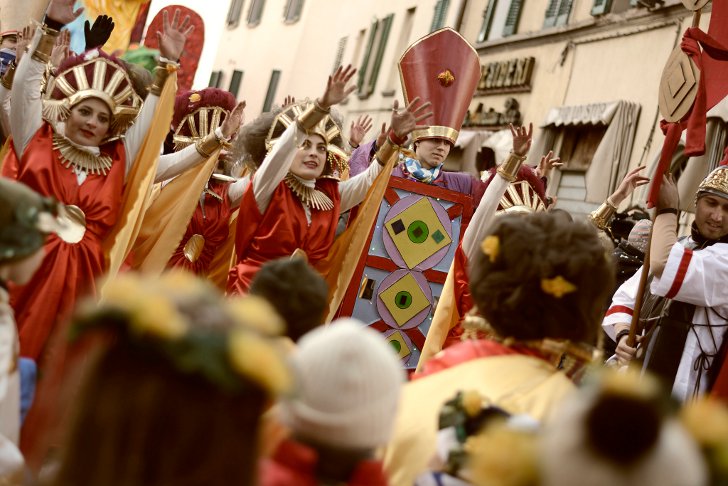The carnival season in Tuscany lasts for about a month, starting in late January or early February and culminating on Shrove Tuesday (Mardi Gras). Most festive events are held on Sundays in order to provide entertainment to as many people as possible, locals and tourists alike.
The Carnival of Foiano della Chiana in its modern form was inaugurated in the 1930s, but its roots date back to 1539. It features a variety of events including parties, masked balls, tastings, exhibitions, children’s events, etc. But the real highlight of the carnival is its parade.
All participates of the parade are divided into four cantieri: the Azzurri (“azures”), the Rustici (“rustics”), the Bombolo (“plumps”), and the Nottambuli (“night owls”). The cantieri that no longer exist include the Pacifici (“peacefuls”), the Cuccioli (“puppies”) and the Vitelloni (“big calves”). Each cantiere makes a festively decorated float using papier-mâché. The floats can be allegorical or portray a public figure, celebrity or pop culture phenomenon. It takes nearly a year to create a float.
During the parade, a jury comprising a painter, a sculptor, a scenographer, an art critic and a journalist chooses the best float. The cantiere that wins the float contest is awarded with the Carnival Cup (Coppa del Carnevale). The float parade is followed by the masked parade which is open to everyone. Revelers wear colorful masks inspired by the Commedia dell’arte. Three best masks are awarded with special prizes.
The carnival season in Foiano della Chiana culminates around Fat Tuesday, the last day before the beginning of Lent. It features the symbolic funeral of Giocondo, King of the Carnival. An effigy of Giocondo is made from straw and rags and put on a special platform created by the four cantieri.
The procession featuring the platform with the effigy and members of Giocondo’s entourage carrying lanterns marches to the main square where a herald reads a testament of the year’s events. Then the effigy is burnt as a form of collective purification for the people of Foiano della Chiana.

Photo by Irene Tartaglia Polcini




